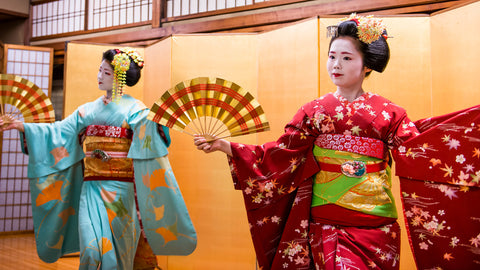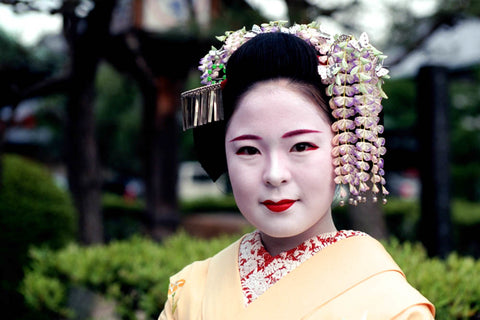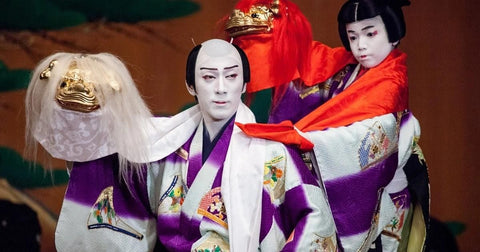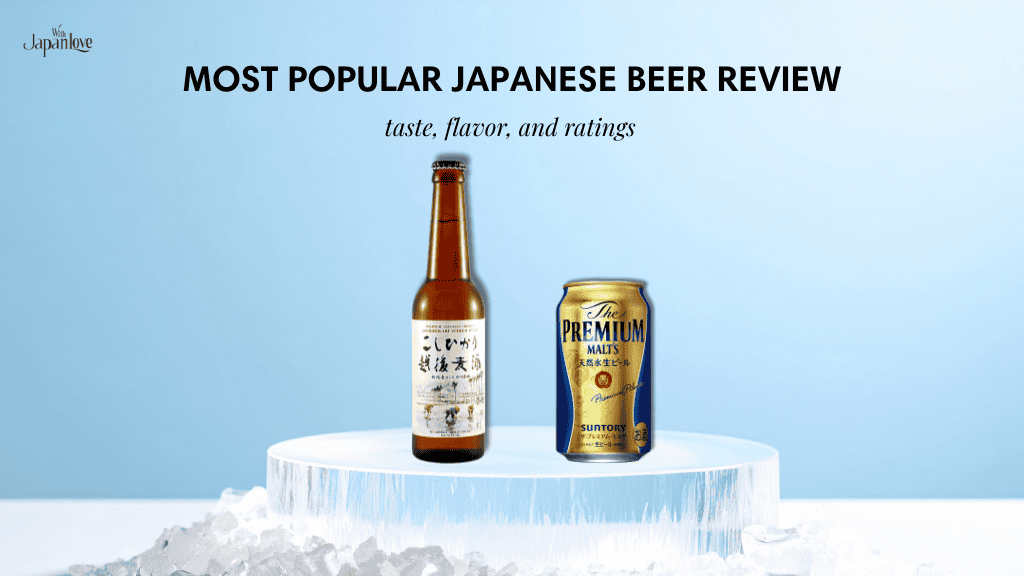El maquillaje tradicional japonés se ha convertido en el símbolo cultural de la nación, yendo más allá de los estándares de belleza del pasado. Este artículo le guía a través de todos los estilos de maquillaje japonés característicos, tradicionales pero que aún muestran sus efectos en la belleza contemporánea y los estilos de maquillaje, así como su influencia en muchas marcas de maquillaje japonesas en la actualidad.
1. Geisha
Uno de los estilos de maquillaje tradicional japonés más emblemáticos es el estilo Geisha. Para comprender su influencia duradera, comenzamos con su rica historia, que refleja los valores culturales e ideales estéticos de su tiempo.
1.1. Historia
Una geisha (芸者) solía usar este tipo de maquillaje, lo que hizo que el maquillaje de Geisha se convirtiera en el nombre oficial. Las geishas son artistas e intérpretes japonesas de gran talento, capacitadas en los estilos tradicionales de artes escénicas japonesas. Era común que una geisha dedicara años a dominar su oficio, lo que las convertía en algo más que simples artistas.
El maquillaje de geisha es tan característico que se ha convertido en uno de los símbolos culturales japoneses. La primera versión de Geisha fue en el período Heian (794 - 1185) y luego giró a lo largo de los períodos históricos. Podría convertirse en el maquillaje distintivo de geisha que reconocemos hoy en día durante el período Edo, entre los siglos XVII y XIX.
1.2. Características clave
Oshiroi (base blanca), Beni (labios rojos) y Hineri (cejas) son tres elementos clave en el maquillaje de Geisha. Las mujeres japonesas usaban polvo de arroz para lograr una tez impecable, como de porcelana, después de aplicar varias capas.
La razón de una capa tan gruesa de polvo podría ser la falta de aerosoles fijadores como Kose setting spray como ahora para mantener su maquillaje. Sin embargo, la aplicación gruesa hizo que fuera muy difícil quitar el maquillaje después debido a la disponibilidad de aceite desmaquillante como Aceite limpiador Shu Uemura.
El cártamo o benibana eran ingredientes populares que las geishas usaban para hacer el color rojo de los labiales. Diferentes tonos y formas de pintura de labios mostraban la edad y la experiencia de la geisha. Por último, pero no menos importante, están las cejas esculpidas meticulosamente con un pincel fino y tinta negra.
1.4. Significado cultural
El maquillaje de geisha sirve como una representación visual de sofisticación, arte y patrimonio cultural. Representa su dedicación a su oficio, su adhesión a la tradición y su papel como embajadoras culturales. Existen muchos estereotipos dañinos sobre la cultura Geisha; por lo tanto, es crucial reconocer las complejidades que rodean este símbolo cultural japonés para el respeto y el aprecio.
2. Maiko
Otro estilo tradicional significativo es el estilo Maiko, conocido por su apariencia juvenil y elaborada. Para apreciar su belleza, es importante primero explorar la historia detrás de Maiko y su papel en la cultura japonesa.
2.1. Historia
Maiko, o aprendiz de geisha, son figuras cautivadoras en la cultura japonesa, y su fama se debía principalmente a su gracia, arte y estilo de maquillaje único. El origen del maquillaje de Maiko podría haber surgido alrededor de los siglos XVII y XVIII junto con la profesión de geisha. El maquillaje temprano de maiko probablemente tomó prestados elementos del maquillaje de geisha, sin embargo, su estilo de maquillaje evolucionó y se hizo distinto del maquillaje de geisha para mantener su propio significado histórico, significado simbólico y belleza cautivadora.
2.2. Características clave
La base blanca del maquillaje de Maiko solía ser más gruesa que el estilo Geisha, además de una base extendida por el cuello y el pecho. El propósito de este look era crear una apariencia juvenil y de muñeca.
El color de lápiz labial que usaba Maiko sería rojo más brillante en comparación con la geisha. Maiko solía pintarse los labios en forma de corazón o forma redonda en aquel entonces.
A diferencia de las cejas delgadas de la geisha, el estilo que usaba Maiko tenía una forma más suave y curva, transmitiendo la inocencia de las niñas. Por último, pero no menos importante, estaba Hanazome, un pequeño punto rojo entre las cejas, para simbolizar la buena suerte y el centro de la sabiduría.
2.3. Significado cultural
Los colores más brillantes y la base más gruesa diferencian a Maiko de Geisha, ya que todavía están en su etapa de entrenamiento y son jóvenes. El estilo de maquillaje de Maiko también se ha convertido en el símbolo japonés de la cultura.
3. Kabuki
El maquillaje Kabuki audaz y dramático es otro elemento clave de la estética tradicional japonesa. Para comprender su sorprendente impacto visual, comenzamos analizando sus raíces históricas y su significado cultural en el teatro japonés.
3.1. Historia
El maquillaje kabuki es famoso por su maquillaje llamativo y dramático de artistas escénicos. Tiene una rica historia y juega un papel crucial en la transmisión de personajes, emociones y simbolismo dentro de las obras de Kabuki. Los orígenes del maquillaje kabuki pueden llevarnos al siglo XVII, cuando surgió la forma de arte en sí. Los primeros actores de kabuki aplicaron elementos del maquillaje del teatro Noh con máscaras más simples y marcas simbólicas utilizadas.
3.2. Características clave
Al igual que el estilo de maquillaje Geisha, Kabuki también usó una base blanca (Oshiroi) de polvo de arroz u óxido de zinc. La base blanca apoyó el resaltado de elementos dramáticos de líneas y patrones (Kumadori).
Las líneas de estilo Kabuki pueden ser rectas, curvas o rotas para enfatizar los rasgos faciales como los ojos, las cejas y la boca. Pueden extenderse hacia las sienes o el cuello para crear un efecto de máscara. Había varios patrones y símbolos en el maquillaje de Kabuki con diferentes significados que representaban la naturaleza o el estatus social del personaje. Por ejemplo, los patrones de cuadros podrían representar demonios, mientras que los diseños estilizados de nubes podrían indicar nobleza.
3.3. Significado cultural
Kabuki no es solo un estilo de maquillaje, sino un lenguaje visual para transmitir la personalidad, el estatus social y el estado emocional del personaje en la obra. En otras palabras, se convierte en una herramienta crucial para la comunicación no verbal, asegurando que el público comprenda las complejidades de los personajes y la narrativa.
La eliminación de diálogos o exposiciones extensas hace que la obra sea más interesante y valiosa para las observaciones profundas. Kabuki encarna las ricas tradiciones y el patrimonio artístico del teatro kabuki, lo que lo convierte en un tesoro nacional de Japón.
4. Significado cultural del maquillaje tradicional japonés
Más allá de su atractivo estético, el antiguo maquillaje tradicional japonés tiene un profundo significado dentro del tejido cultural de Japón. Trasciende la definición de belleza en sí misma, pero sirve como un poderoso lenguaje visual que refleja el estatus social, la expresión artística y las creencias profundamente arraigadas.
4.1. Estatus social
Históricamente, el maquillaje era la señal que indicaba a otras personas la posición social de una persona, especialmente de las mujeres. Durante el período Edo, un maquillaje elaborado adornaba los rostros de mujeres aristocráticas y cortesanas. Mientras tanto, usar poco o ningún maquillaje indicaba que los individuos eran plebeyos.
Además, podrías usar el estilo de maquillaje de una mujer como pista de su estado civil. Por ejemplo, si una mujer tenía ohaguro (ennegrecimiento de los dientes), un peinado con moño redondo y cejas sin afeitar, se casaba. Mientras tanto, una chica soltera tendría un adorno para el cabello precioso con un labio inferior pintado de verde. El estilo se llamaba “sasa shirobeni” (rouge rojo hierba de bambú).
4.2. Actuación artística
Puede encontrar fácilmente características distintivas de base blanca, labios rojos y cejas meticulosamente pintadas en muchos estilos de maquillaje japoneses antiguos, como el maquillaje de Geisha y kabuki. Estos elementos dramáticos realzaron el impacto emocional de la actuación, mostrando su papel como guardianes culturales o dejando una impresión duradera en el público.
4.3. Simbolismo y significados
Más que por la apariencia, el maquillaje tradicional japonés tiene un rico simbolismo. Por ejemplo, la base blanca representa la pureza y el refinamiento, mientras que los labios rojos insinúan sensualidad y vitalidad. Las líneas dramáticas en el estilo kabuki expresan la personalidad y las emociones del individuo.
El recorrido por tres estilos de maquillaje tradicional japonés, incluidos Geisha, Maiko y Kabuki, con suerte proporciona información interesante sobre cómo las mujeres japonesas se maquillaban en el pasado. Puede ver que estos estilos trascienden los antiguos estándares de belleza, pero conllevan ricos significados culturales y significados profundos.
Siga a Japan With Love para obtener más artículos culturales sobre la belleza japonesa, las tendencias de maquillaje y los productos para el cuidado de la piel.


















Compartir:
How to double cleanse? 2-step ritual for clear, balanced skin
Revisión exhaustiva de DHC Collagen: una lectura obligada antes de comprar